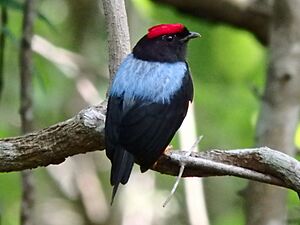Lance-tailed manakin facts for kids
Quick facts for kids Lance-tailed manakin |
|
|---|---|
 |
|
| Conservation status | |
| Scientific classification | |
| Genus: |
Chiroxiphia
|
| Species: |
lanceolata
|
 |
|
The lance-tailed manakin (Chiroxiphia lanceolata) is a small, colorful bird. It lives in warm, tropical areas of Central and South America. You can find it from Costa Rica all the way to northern Venezuela.
This bird is a type of manakin. It prefers dry or moist forests, but not thick rainforests. It's a small, round bird, about 13 cm (5 inches) long. Both male and female lance-tailed manakins have two long, spiky feathers in the middle of their tail. Males are mostly black with a bright blue back and a red cap. They also have bright orange legs. Females and young birds are mostly olive-green with lighter undersides.
One cool thing about these birds is how the males work together during breeding season. They jump up and down to impress the females! This bird is quite common, and its numbers are stable. Because of this, experts say it's a "least concern" species.
What Does It Look Like?
The lance-tailed manakin is a small, brightly colored forest bird. It's usually about 13.5 cm (5.3 inches) long and weighs around 17.5 g (0.6 ounces). Both male and female birds have bright orange legs. They also have two central tail feathers that are longer and look like a spike.
Female manakins are mostly olive-green. Their undersides are a bit lighter. Most females are solid green, but some might have a reddish-brown or red cap. Adult males are mostly black. They have a bright red cap on their head and a sky-blue back. Young males start out olive-green. As they grow, they begin to show a red cap and a blue back. Male lance-tailed manakins don't get their full adult colors until they are about 26 months old.
This species looks a bit like the blue-backed manakin, Chiroxiphia pareola. That bird lives further south and east. However, the blue-backed manakin doesn't have the spiky tail. Also, the male blue-backed manakin has a slightly darker blue back.
Life and Habits
Male lance-tailed manakins have a very interesting way of attracting females. It's unusual because they work together instead of competing! Two males will sit side-by-side on a bare stick. Then, they take turns jumping up and down. Sometimes they even make short flights. Groups of birds might perform together. Each pair of displaying males uses a different stick.
The female bird builds a cup-shaped nest in a tree. She lays two cream-colored eggs with brown spots. The female does all the work of incubating the eggs. This means she sits on them to keep them warm for about 20 days.
The lance-tailed manakin makes several different sounds. These include a "Toe-LEE-do" call and a "curry-ho" call. Displaying males also make a buzzing croak that sounds a bit like a frog. These manakins mostly eat fruit, but they also snack on some insects.
Conservation Status
The lance-tailed manakin lives across a very large area. It's also quite common, and its total population is thought to be big. The number of these birds seems to be stable. Because of its wide range and stable population, the International Union for Conservation of Nature has listed this bird as being of "least concern". This means it's not currently in danger of disappearing.


